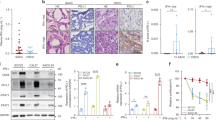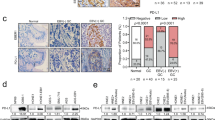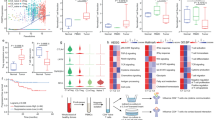Abstract
The prevalence of nasopharyngeal cancer (NPC) is high in the southern area of China and some other districts in the world. The pathogenesis of NPC is unclear. It is reported that some microRNAs (miR) are involved in the progression of NPC. This study aims to investigate the role of miR-21 in the induction of immune tolerance of NPC. In this study, NPC tissue was collected from patients with NPC. Assessment of miR was performed with real time quantitative RT-PCR. Western blotting was used to assess proteins of interleukin 10 and nuclear factor I-A (NFI-A). Immune cells were analyzed by flow cytometry. The results showed that NPC cell line C666-1 and surgically removed NPC tissue expressed miR-21, which was upregulated by the presence of the Toll-like receptor 3 ligand, Poly I: C. Exposure to miR-21 increased the expression of NFI-A and interleukin (IL)-10 in naive B cells. High frequency of IL-10+ B cells was detected in the NPC tissue. The NPC- or miR-21-primed B cells suppressed cytotoxic CD8+ T cell activities. We conclude that NPC-derived miR-21 induces IL-10+ B cells; the latter is capable of suppressing CD8+ T-cell activities. miR-21 may be a potential target in the treatment of NPC.
This is a preview of subscription content, access via your institution
Access options
Subscribe to this journal
Receive 12 digital issues and online access to articles
$119.00 per year
only $9.92 per issue
Buy this article
- Purchase on Springer Link
- Instant access to full article PDF
Prices may be subject to local taxes which are calculated during checkout






Similar content being viewed by others
References
Zhang L, Chen QY, Liu H, Tang LQ, Mai HQ . Emerging treatment options for nasopharyngeal carcinoma. Drug Des Devel Ther 2013; 7: 37–52.
Pan CC, Lu J, Yu JR, Chen P, Li W, Huang ZL et al. Challenges in the modification of the M1 stage of the TNM staging system for nasopharyngeal carcinoma: a study of 1027 cases and review of the literature. Exp Ther Med 2012; 4: 334–338.
Alon EE, Lipschitz N, Bedrin L, Gluck I, Talmi Y, Wolf M et al. Delayed sino-nasal complications of radiotherapy for nasopharyngeal carcinoma. Otolaryngol Head Neck Surg 2014; 151: 354–358.
Nishikawa H, Sakaguchi S . Regulatory T cells in cancer immunotherapy. Curr Opin Immunol 2014; 27: 1–7.
Mahalingam J, Lin CY, Chiang JM, Su PJ, Chu YY, Lai HY et al. CD4+ T cells expressing latency-associated peptide and Foxp3 are an activated subgroup of regulatory T cells enriched in patients with colorectal cancer. PLoS One 2014; 9: e108554.
Chung AY, Li Q, Blair SJ, de Jesus M, Dennis KL, LeVea C et al. Oral interleukin-10 alleviates polyposis via neutralization of pathogenic T-regulatory cells. Cancer Res 2014; 74: 5377–5385.
Wang BQ, Zhang CM, Gao W, Wang XF, Zhang HL, Yang PC . Cancer-derived matrix metalloproteinase-9 contributes to tumor tolerance. J Cancer Res Clin Oncol 2011; 137: 1525–1533.
Ambros V . The functions of animal microRNAs. Nature 2004; 431: 350–355.
Vincent K, Pichler M, Lee GW, Ling H . MicroRNAs, genomic instability and cancer. Int J Mol Sci 2014; 15: 14475–14491.
Shin VY, Chu KM . MiRNA as potential biomarkers and therapeutic targets for gastric cancer. World J Gastroenterol 2014; 20: 10432–10439.
Li Y, Yan L, Zhang W, Wang H, Chen W, Hu N et al. miR-21 inhibitor suppresses proliferation and migration of nasopharyngeal carcinoma cells through down-regulation of BCL2 expression. Int J Clin Exp Pathol 2014; 7: 3478–3487.
Sekar D, Hairul Islam VI, Thirugnanasambantham K, Saravanan S . Relevance of miR-21 in HIV and non-HIV-related lymphomas. Tumour Biol 2014; 35: 8387–8393.
Wang L, He L, Zhang R, Liu X, Ren Y, Liu Z et al. Regulation of T lymphocyte activation by microRNA-21. Mol Immunol 2014; 59: 163–171.
Liu T, He SH, Zheng PY, Zhang TY, Wang BQ, Yang PC . Staphylococcal enterotoxin B increases TIM4 expression in human dendritic cells that drives naive CD4 T cells to differentiate into Th2 cells. Mol Immunol 2007; 44: 3580–3587.
Zhang HP, Wu Y, Liu J, Jiang J, Geng XR, Yang G et al. TSP1-producing B cells show immune regulatory property and suppress allergy-related mucosal inflammation. Sci Rep 2013; 3: 3345.
Berin MC, Yang PC, Ciok L, Waserman S, Perdue MH . Role for IL-4 in macromolecular transport across human intestinal epithelium. Am J Physiol 1999; 276: C1046–C1052.
Wang M, Gu H, Wang S, Qian H, Zhu W, Zhang L et al. Circulating miR-17-5p and miR-20a: molecular markers for gastric cancer. Mol Med Rep 2012; 5: 1514–20.
Schmittgen TD, Livak KJ . Analyzing real-time PCR data by the comparative CT method. Nat Protoc 2008; 3: 1101–1108.
Geng XR, Yang G, Li M, Song JP, Liu ZQ, Qiu S et al. Insulin-like growth factor-2 enhances functions of antigen (Ag)-specific regulatory B cells. J Biol Chem 2014; 289: 17941–17950.
Czarneski J, Lin YC, Chong S, McCarthy B, Fernandes H, Parker G et al. Studies in NZB IL-10 knockout mice of the requirement of IL-10 for progression of B-cell lymphoma. Leukemia 2004; 18: 597–606.
Liu X, Luo HN, Tian WD, Lu J, Li G, Wang L et al. Diagnostic and prognostic value of plasma microRNA deregulation in nasopharyngeal carcinoma. Cancer Biol Ther 2013; 14: 1133–1142.
Quinn SR, O'Neill LA . The role of microRNAs in the control and mechanism of action of IL-10. Curr Top Microbiol Immunol 2014; 380: 145–155.
Zhang Y, Sun R, Liu B, Deng M, Zhang W, Li Y et al. TLR3 activation inhibits nasopharyngeal carcinoma metastasis via downregulation of chemokine receptor CXCR4. Cancer Biol Ther 2009; 8: 1826–1830.
McClure C, Brudecki L, Ferguson DA, Yao ZQ, Moorman JP, McCall CE et al. MicroRNA 21 (miR-21) and miR-181b couple with NFI-A to generate myeloid-derived suppressor cells and promote immunosuppression in late sepsis. Infect Immun 2014; 82: 3816–3825.
Jin G, Hamaguchi Y, Matsushita T, Hasegawa M, Le Huu D, Ishiura N et al. B-cell linker protein expression contributes to controlling allergic and autoimmune diseases by mediating IL-10 production in regulatory B cells. J Allergy Clin Immunol 2013; 131: 1674–1682.
Karray H, Ayadi W, Fki L, Hammami A, Daoud J, Drira MM et al. Comparison of three different serological techniques for primary diagnosis and monitoring of nasopharyngeal carcinoma in two age groups from Tunisia. J Med Virol 2005; 75: 593–602.
Yang CF, Peng LX, Huang TJ, Yang GD, Chu QQ, Liang YY et al. Cancer stem-like cell characteristics induced by EB virus-encoded LMP1 contribute to radioresistance in nasopharyngeal carcinoma by suppressing the p53-mediated apoptosis pathway. Cancer Lett 2014; 344: 260–271.
He JF, Jia WH, Fan Q, Zhou XX, Qin HD, Shugart YY et al. Genetic polymorphisms of TLR3 are associated with nasopharyngeal carcinoma risk in Cantonese population. BMC Cancer 2007; 7: 194.
Yang GD, Huang TJ, Peng LX, Yang CF, Liu RY, Huang HB et al. Epstein–Barr virus-encoded LMP1 upregulates microRNA-21 to promote the resistance of nasopharyngeal carcinoma cells to cisplatin-induced Apoptosis by suppressing PDCD4 and Fas-L. PLoS One 2013; 8: e78355.
Wisniewski J, Agrawal R, Woodfolk JA . Mechanisms of tolerance induction in allergic disease: integrating current and emerging concepts. Clin Exp Allergy 2013; 43: 164–176.
Mauri C, Ehrenstein MR . The ‘short’ history of regulatory B cells. Trends Immunol 2008; 29: 34–40.
Hu H, Jiang W, Xi X, Zou C, Ye Z . MicroRNA-21 Attenuates renal ischemia reperfusion injury via targeting caspase signaling in mice. Am J Nephrol 2014; 40: 215–223.
Acknowledgements
This study was supported by grants from the innovation of science and Technology Commission of Shenzhen Municipality (JCYJ20120613161724279 and JCYJ20120613172559904).
Author information
Authors and Affiliations
Corresponding authors
Ethics declarations
Competing interests
None to declare.
Rights and permissions
About this article
Cite this article
Miao, BP., Zhang, RS., Li, M. et al. Nasopharyngeal cancer-derived microRNA-21 promotes immune suppressive B cells. Cell Mol Immunol 12, 750–756 (2015). https://doi.org/10.1038/cmi.2014.129
Received:
Revised:
Accepted:
Published:
Issue Date:
DOI: https://doi.org/10.1038/cmi.2014.129
Keywords
This article is cited by
-
Regulation of PD-1/PD-L1 Pathway in Cancer by Noncoding RNAs
Pathology & Oncology Research (2020)
-
Extracellular Vesicles As miRNA Nano-Shuttles: Dual Role in Tumor Progression
Targeted Oncology (2018)
-
An update: Epstein-Barr virus and immune evasion via microRNA regulation
Virologica Sinica (2017)
-
MiR-21: an environmental driver of malignant melanoma?
Journal of Translational Medicine (2015)



